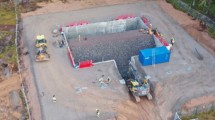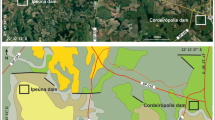Abstract
Internal erosion is a major reason for embankment dam failures. Resistivity measurements is an essentially non-destructive technique, which may have the possibility of detecting internal erosion processes and anomalous seepage at an early stage before the safety of the dam is at stake. This paper presents results from part of a dam safety investigation conducted at the Enemossen tailings dam in southern Sweden. Longitudinal resistivity sections, 2D measurements along the dam crest, provided an overview of the whole dam and served to detect anomalous zones. In selected areas, additional cross-sectional 2D surveys gave detailed information about the geo-electrical situations in the embankments. This information is valuable for similar investigations as information about resistivity in embankment construction material is scarce. Known problem areas were associated with low resistivities, even though the resistivity measurements alone did not provide enough information to confidently come to a decision about the status of the dams.



Similar content being viewed by others
Notes
Developed by M.H. Loke, available for example at http://www.geoelectrical.com.
References
Abraheem AM, Hamburger MW, Bayless ER, Krothe NC (1990) A study of acid mine drainage using earth resistivity measurements. Groundwater 28:361–368
Benckert A (2003) Tailings dam safety in Sweden. Proc. International Symposium on Major Challenges in Tailings Dams 71st Annual Meeting of the International Commission on Large Dams (ICOLD), 15 June 2003, Montreal, Canada:35–45
Buselli G, Lu K (2001) Groundwater contamination monitoring with multichannel electrical and electromagnetic methods. J Appl Geophys 48:11–23
Dahlin T, Sjödahl P, Friborg J, Johansson S (2001) Resistivity and SP Surveying and Monitoring at the Sädva Embankment Dam, Sweden. Dams in a European Context, Mistømme GH, Honningsvåg B, Repp K, Vaskinn KA, Westeren T (eds), ISBN 90 5809 196 1, Balkema, Lisse: 107–113
Fell R, MacGregor P, Stapledon D (1992) Geotechnical engineering of embankment dams. Balkema, Rotterdam, p 675
Johansson S, Dahlin T (1998) Seepage monitoring in Hällby embankment dam by continuous resistivity measurements. Procs. 8th Congress of the International Ass. of Eng. Geology and the Environment, Vancouver, 21–25 September 1998: 8p
Loke MH, Acworth I, Dahlin T (2003) A comparison of smooth and blocky inversion methods in 2-D electrical imaging surveys. Explor Geophys 34:182–187
Panthulu TV, Krishnaiah C, Shirke JM (2001) Detection of seepage paths in earth dams using self-potential and electrical resistivity methods. Eng Geol 59:281–295
Salmon GM, Johansson S (2003) Research on Geophysical Methods of Detecting Seepage and Piping in Embankment Dams with Case Studies of Geophysical Measurements at Two Swedish Tailings Dams. Procs. International Symposium on Major Challenges in Tailings Dams 71st Annual Meeting of the International Commission on Large Dams (ICOLD), 15 June 2003, Montreal, Canada: 275–289
SWECO (2003) Geotekniska Undersökningar vid Enemossen –Utvärdering av resultat från geotekniska undersökningar I Zinkgruvans sandmagasin. Technical report from the consultant group Sweco VBB, Comission # 2166012: 9p (In Swedish)
Titov K, Lokhmanov V, Potapov A (2000) Monitoring of water seepage from a reservoir using resistivity and self polarization methods: case history of the Petergoph fountain water supply system. First Break 18:431–435
Van Tuyen D, Canh T, Weller A (2000) Geophysical investigations of river dikes in Vietnam. Eur J Environ Eng Geophys 4:195–206
Voronkov OK, Kagan AA, Krivonogova NF, Glagovsky VB, Prokopovich VS (2004) Geophysical methods and identification of embankment dam parameters. Procs. 2nd International Conference on Site Characterization (ISC), Porto, Portugal, 19–22 September 2004:593–599
Yuval, Oldenburg DW (1996) DC resistivity and IP methods in acid mine drainage problems: results from the copper cliff mine tailings impoundments. J Appl Geophys 34:187–198
Acknowledgements
The work presented here was carried out on behalf of Fred Mellberg at Zinkgruvan Mining AB. Åke och Greta Lissheds Stiftelse and Swedish Association of Graduate Engineers (Civilingenjörsförbundets Miljöfond) funded the research and development work that paved the way for the time-efficient and high-quality field survey. We are grateful to Alfredo Mendoza and Ola Mårtensson for valuable field assistance.
Author information
Authors and Affiliations
Corresponding author
Rights and permissions
About this article
Cite this article
Sjödahl, P., Dahlin, T. & Johansson, S. Using resistivity measurements for dam safety evaluation at Enemossen tailings dam in southern Sweden. Environ Geol 49, 267–273 (2005). https://doi.org/10.1007/s00254-005-0084-1
Received:
Accepted:
Published:
Issue Date:
DOI: https://doi.org/10.1007/s00254-005-0084-1




